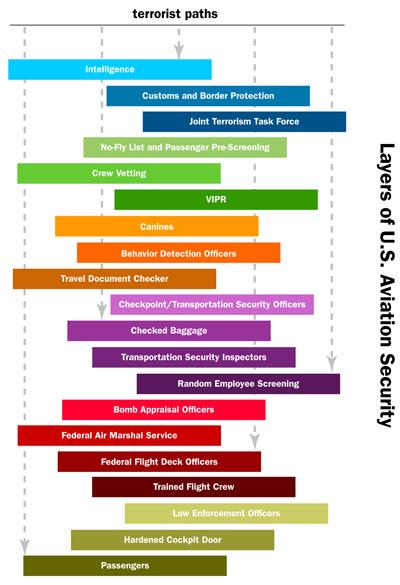TSA and their “Layers of Security” – Hype and Secrecy?
For years we’ve been hearing about the TSA and their “Layers of Security”. However, the TSA doesn’t really go into much detail about this concept, except for a 146-word article on their website. So we thought we’d give you the baseline on what it actually is.
Here’s the most substantial thing the TSA has to say about it;
Each one of these layers alone is capable of stopping a terrorist attack. In combination their security value is multiplied, creating a much stronger, formidable system. A terrorist who has to overcome multiple security layers in order to carry out an attack is more likely to be pre-empted, deterred, or to fail during the attempt.
“Defense in Depth”
While what the TSA is saying is sort of true, it’s not a new concept, it’s not new or unique to security, and in fact, it’s just about the most widely accepted method of securing and protecting assets out there today. The concept is knows as “defense in depth”, and is described in the the first chapter of almost any serious book on security.
“Defense in depth” is simple, as a concept, but can be made to be as complicated as one would ever wish. Here’s the basics, though:
– Deterrence. Discouraging crime and criminals is never a bad idea.
– Detection. Identifying threats as soon as possible.
– Delay. Delaying an attack long enough for a defense to be mounted.
Aaaaand…that’s it, really. Everything else fits in under one of these neat little categories.
The TSA Hype-Machine
On the one hand, the TSA wants you to believe that they can’t comment on anything they do when it comes to security. On the other hand, they’re doing an awesome job hyping up a security concept as old as medieval castles – well, actually it goes back further than that, but let’s keep it there for simplicity.
While the concept of defense in depth really only has three layers, the TSA has hyped their approach up to contain about 20. Let’s take a look at what they’re actually operating with, shall we?

As you can clearly see, there’s something strange going on here. The TSA lists several law enforcement agencies as separate layers. CBP, JTF and FAMS, for example, aren’t separate “layers of security”. Basically, they all do the same thing. Oh, and let’s add “Law Enforcement Officers” to that group, since, well… that’s what all of them are. Except the TSOs, of course…
Then there are the TSA’s own ragtag crew of letters. Let’s see. There are BDOs, TDCs, TSOs and TSIs, which are all in the same business. They’re under the “detection” heading, by the way – they’re far from separate “layers of security”. It all becomes a bit silly, really.
The TSA’s 3 Levels of Security
Here’s what it all really looks like:
DETERRENCE:
Checkpoints / TSOs / other TSA staff
Random employee screening
Hardened cocpit doors
Law enforcement agencies
DETECTION:
Intelligence
Crew vetting (should really be under “intelligence”… but whatever)
TSA and their 3-letter crews
Law enforcement agencies
DELAY:
FAMS
Hardenened cockpit doors
Passengers
The TSA claims that running into any single one of their “20” layers of security can stop a terrorist or similar miscievous person on its own, but that they’re employing “20” layers to makes sure you’re as safe as can be. As we’ve shown you, the TSA has 3 layers. While any 1 of those 3 can stop a terrorist or terrorist plot, any 1 of the TSAs 20 can not.
Oh, and while we’re on the subject of not stopping terrorists… hype, waste, secrecy and lies does nothing to increase security either. Which is all the TSA seems capable of these days.

You need a strong financial foundation which is your conscious and sub conscious state
of mind. A single toggle switch allows you to choose three different settings.
A is more convenient compared to the wired counterpart.